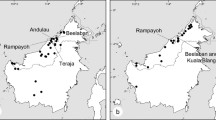Abstract
Some plants are exclusively pollinated by an insect whose larvae feed on their seeds. The net outcome of a single visit for the plant depends on the number of ovules fertilised by the visitor, the number of eggs laid, and the number of seeds eaten by each larva. Unlike other known plant-seed eater pollinating mutualisms, the globeflower-globeflower fly mutualism (Trollius europaeus-Chiastocheta spp.) is unique in that not only females but also males visit flowers, and both sexes are potential pollinators. I analysed the relative efficiency of Chiastocheta males versus females in transporting pollen and fertilising globeflower ovules. I show that there is no sex-specific morphological adaptation or behaviour to enhance pollen collection and transportation in Chiastocheta flies, and that males contribute to pollination. However, because of their smaller body size, males transport significantly less pollen than females. Less seeds are produced after a visit from a male than after a visit from a female. A single female visit contributes to about 12% of total seed production, and a single male visit to only 5.4%. Females tend to spend more time inside the flower than males, and the number of ovules fertilised is significantly correlated with the time insects spent inside the closed corolla. The lower efficiency of ovule fertilisation by a male's single visit is compensated for by the higher rate of flower visitation by males: a flower receives about twice as many visits from males as from females during a time unit. The contribution of males to pollination is of major importance with respect to understanding the evolutionary stability of the globeflower-globeflower fly mutualism, as males satiate pollen requirement of flowers, masking the antagonistic effect of ovipositing females.


Similar content being viewed by others
References
Addicott JF (1986) Variation in the costs and benefits of mutualism: the interaction between yuccas and yucca moths. Oecologia 70:486–494
Bronstein JL (1992) Seed predators as mutualists: ecology and evolution of the fig/pollinator interaction. In: Bernays E (ed) Insect-plant interactions, vol IV. CRC, Boca Raton, Fla., pp 1–44
Després L, Jaeger N (1999) Evolution of oviposition strategies and speciation in the globeflower flies Chiastocheta spp. (Anthomyiidae). J Evol Biol 12:822–831
Dogterom MH, Winston ML, Mukai A (2000) Effect of pollen load size and source (self, outcross) on seed and fruit production in highbush blueberry cv. "Bluecrop" (Vaccinium corymbosum; Ericaceae). Am J Bot 87:1584–1591
Donaldson JS (1997) Is there a floral parasite mutualism in cycad pollination? The pollination biology of Encephalartos villosus (Zamiaceae). Am J Bot 84:1398–1406
Fleming TH, Holland JN (1998) The evolution of obligate pollination mutualisms: senita cactus and senita moth. Oecologia 114:368–375
Galil J, Neeman G (1977) Pollen transfer and pollination in the common fig (Ficus carica L.). New Phytol 79:163–171
Hagerup O, Peterson V (1956) Botanisk atlas I. Munkegaard, Copenhagen
Hemborg A, Després L (1999) Oviposition by mutualistic seed parasitic pollinators and its effects on annual fitness of single and multi-flowered host plants. Oecologia 120:427–436
Herre EA (1987) Sex ratio adjustment in fig wasps. Science 228:896–898
Holland JN, DeAngelis DL, Bronstein JL (2002) Population dynamics and mutualism: functional responses of benefits and costs. Am Nat 159:231–244
Jaeger N, Després L (1998) Obligate mutualism between Trollius europaeus and its seed-parasite pollinators Chiastocheta flies in the Alps. C R Acad Sci Paris 321:789–796
Jaeger N, Till-Bottraud I, Després L (2000) Evolutionary conflict between Trollius europaeus and its seed-parasite pollinators Chiastocheta flies. Evol Ecol Res 2:885–896
Jaeger N, Pompanon F, Després L (2001) Variation in predation costs with Chiastocheta egg number on Trollius europaeus: how many seeds to pay for pollination? Ecol Entomol 26:56–62
Johnson SD, Steiner KE (2000) Generalization versus specialization in plant pollination systems. Trends Ecol Evol 15:140–143
Marshall DL, Avritt JJ, Shaner M, Saunders RL (2000) Effects of pollen load size and composition on pollen donor performance in wild radish, Raphanus sativus (Brassicaceae). Am J Bot 87:1619–1627
Patt JM, French JC, Schal C, Lech J, Hartman TG (1995) The pollination biology of Tuckaoe, Peltandra virginica (Araceae). Am J Bot 82:1230–1240
Pellmyr O (1989) The cost of mutualism: interactions between Trollius europaeus and its pollinating parasites. Oecologia 78:53–59
Pellmyr O (1997) Pollinating seed eaters: why is active pollination so rare? Ecology 78:1655–1660
Pellmyr O, Huth CJ (1994) Evolutionary stability of mutualism between yuccas and yucca moths. Nature 372:257–260
Pellmyr O, Patt JM (1986) Function of olfactory and visual stimuli in the pollination of of Lysichiton americanum by a staphylinid beetle. Madrono 3:47–54
Pettersson MW (1991) Pollination by a guild of fluctuating moth populations: option for unspecialization in Silene vulgaris. J Ecol 79:591–604
Schemske DW, Horvitz CC (1984) Variation among floral visitors in pollination ability: a precondition for mutualism specialization. Science 225:519–521
Thompson JN (1994) The coevolutionary process. Chicago University Press, Chicago, Ill.
Thompson JN, Pellmyr O (1992) Mutualism with pollinating seed parasites amid co-pollinators: constraints on specialization. Ecology 73:1780–1791
Turchin P, Odendaal FJ, Rausher MD (1991) Quantifying insect movement in the field. Environ Entomol 20:955–963
Wiebes JT (1979) Co-evolution of figs and their insects pollinators. Annu Rev Ecol Syst 10:1–12
Young HJ (1986) Beetle pollination of Dieffenbachia longispatha (Araceae). Am J Bot 73:931–944
Acknowledgements
I thank Julie Siegel, Ophélie Clet, Nicolas Champurney and Pierre Touraille for field assistance. I also thank Stéphanie Blanc-Manel, Irène Till-Bottraud and Finn Kjellberg for critical reading of the manuscript.
Author information
Authors and Affiliations
Corresponding author
Rights and permissions
About this article
Cite this article
Després, L. Sex and pollen: the role of males in stabilising a plant-seed eater pollinating mutualism. Oecologia 135, 60–66 (2003). https://doi.org/10.1007/s00442-003-1181-z
Received:
Accepted:
Published:
Issue Date:
DOI: https://doi.org/10.1007/s00442-003-1181-z




